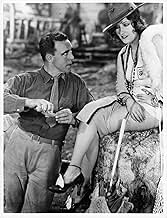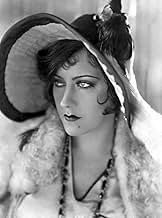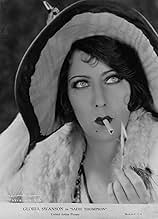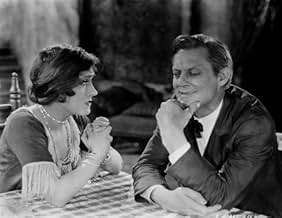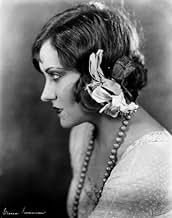AVALIAÇÃO DA IMDb
7,2/10
2,9 mil
SUA AVALIAÇÃO
Adicionar um enredo no seu idiomaA prostitute seeking a fresh start becomes the obsession of a religious extremist.A prostitute seeking a fresh start becomes the obsession of a religious extremist.A prostitute seeking a fresh start becomes the obsession of a religious extremist.
- Direção
- Roteiristas
- Artistas
- Indicado a 2 Oscars
- 3 vitórias e 2 indicações no total
Charles Sullivan
- Marine
- (não creditado)
Avaliações em destaque
For those who would pigeonhole Raoul Walsh as an "action master" or "man's director", this small-focus drama with a female protagonist might seem at odds with his image. In fact, while he was a versatile director who could turn out a rousing action scene, it was the drama particularly in the relationships between individuals that was Walsh's greatest strength. Sadie Thompson in fact shows us his mastery of the technique in its purest form.
Walsh himself made the adaptation from the play "Rain", not as easy a task as it sounds a play has to convey action through dialogue, while a silent film does the exact opposite. Sadie Thompson begins with a series of autograph mottos from each character, a rather clumsy way to introduce character. This is immediately followed however with a particularly smooth bit of film-making. We are given a point-of-view shot, as Swanson looks down at the group of soldiers on the shore, then we cut back to her, and the camera pulls back as she descends the gang plank. A few shots later the camera is dollying forward, following Swanson and the soldiers hovering around her. In this handful of shots we are subtly informed of Miss Thompson's profession, but also with those attention-grabbing point-of-view shots and camera movements we, the audience, are placed into the position of the characters. Walsh has drawn us into the story at this crucial establishing moment.
Considering it only really revolves around two developing relationships that between Sadie and Tim, and that between Sadie and Davidson the main part of the film is like a tour-de-force of different ways to shoot interaction between two people. The scenes between Swanson and Walsh are given the customary tenderness of a regular romance, with some delicate shot compositions that give it a natural, harmonious feel. The relationship between Swanson and Barrymore in contrast is full of intensity lots of cuts, faces framed in stark close-up. What is particularly neat, is that all of the major dialogue scenes begin with a fair few title cards getting the unavoidable wordy bits out of the way first but then the dialogue fizzles out and the interaction continues with just the images, back and forth.
Of course, the effectiveness of the drama would be lost without great acting and, yes, this probably is Swanson's finest performance prior to Sunset Boulevard. I think Swanson was at her best when she was really allowed to let go, and put all her energy into a character, and to say she does that here would be an understatement. Lionel Barrymore is fine as the archetypal repressed Christian, a little hammy perhaps but then, he is a Barrymore. And Walsh himself absolutely acts his socks off, actually turning in the deepest performance of the picture, and the fact that his acting days were soon to be cut short is one of several tragedies regarding his career.
Speaking of tragedies, looming over Sadie Thompson is the unfortunate loss of the final reel, which has since been semi-reconstructed with stills and titles. While what we see today suffers from a very noticeable lack of a climax, the dramatic build up comes close to perfection. Considering its small scale and lack of action, Sadie Thompson was apparently a massive popular success. In his autobiography Raoul Walsh quotes several letters he apparently received from prostitutes of various nationalities which, while they may well have been fabricated or exaggerated slightly, are probably accurate at least in tone. By contrast the 1932 talkie version was a flop, despite an equally great cast, testament to Walsh's talent as a director of powerful cinematic drama.
Walsh himself made the adaptation from the play "Rain", not as easy a task as it sounds a play has to convey action through dialogue, while a silent film does the exact opposite. Sadie Thompson begins with a series of autograph mottos from each character, a rather clumsy way to introduce character. This is immediately followed however with a particularly smooth bit of film-making. We are given a point-of-view shot, as Swanson looks down at the group of soldiers on the shore, then we cut back to her, and the camera pulls back as she descends the gang plank. A few shots later the camera is dollying forward, following Swanson and the soldiers hovering around her. In this handful of shots we are subtly informed of Miss Thompson's profession, but also with those attention-grabbing point-of-view shots and camera movements we, the audience, are placed into the position of the characters. Walsh has drawn us into the story at this crucial establishing moment.
Considering it only really revolves around two developing relationships that between Sadie and Tim, and that between Sadie and Davidson the main part of the film is like a tour-de-force of different ways to shoot interaction between two people. The scenes between Swanson and Walsh are given the customary tenderness of a regular romance, with some delicate shot compositions that give it a natural, harmonious feel. The relationship between Swanson and Barrymore in contrast is full of intensity lots of cuts, faces framed in stark close-up. What is particularly neat, is that all of the major dialogue scenes begin with a fair few title cards getting the unavoidable wordy bits out of the way first but then the dialogue fizzles out and the interaction continues with just the images, back and forth.
Of course, the effectiveness of the drama would be lost without great acting and, yes, this probably is Swanson's finest performance prior to Sunset Boulevard. I think Swanson was at her best when she was really allowed to let go, and put all her energy into a character, and to say she does that here would be an understatement. Lionel Barrymore is fine as the archetypal repressed Christian, a little hammy perhaps but then, he is a Barrymore. And Walsh himself absolutely acts his socks off, actually turning in the deepest performance of the picture, and the fact that his acting days were soon to be cut short is one of several tragedies regarding his career.
Speaking of tragedies, looming over Sadie Thompson is the unfortunate loss of the final reel, which has since been semi-reconstructed with stills and titles. While what we see today suffers from a very noticeable lack of a climax, the dramatic build up comes close to perfection. Considering its small scale and lack of action, Sadie Thompson was apparently a massive popular success. In his autobiography Raoul Walsh quotes several letters he apparently received from prostitutes of various nationalities which, while they may well have been fabricated or exaggerated slightly, are probably accurate at least in tone. By contrast the 1932 talkie version was a flop, despite an equally great cast, testament to Walsh's talent as a director of powerful cinematic drama.
What a performance - Swanson bursts out of the screen, as Somerset Maugham's prostitute heroine trapped on a tropical island with a crusading parson and a sexy sergeant. And Lionel Barrymore as the parson and the director Raoul Walsh as the sergeant are her match. This is silent acting at its best.
Yes the piece is a little stagey and the action too confined for a silent picture, but when the photography is as brilliant as it is here - who cares? It deservedly won the first ever Oscar for cinematography.
This is a passionate and beautiful production. What a tragedy that the last few minutes have been lost. They have been reconstructed using titles and stills - but how I would have loved to have seen the scene when Barrymore rapes Swanson. It must have been breathtaking. Don't miss this film.
Yes the piece is a little stagey and the action too confined for a silent picture, but when the photography is as brilliant as it is here - who cares? It deservedly won the first ever Oscar for cinematography.
This is a passionate and beautiful production. What a tragedy that the last few minutes have been lost. They have been reconstructed using titles and stills - but how I would have loved to have seen the scene when Barrymore rapes Swanson. It must have been breathtaking. Don't miss this film.
I had only seen Gloria Swanson in her more mature role in Sunset Boulevard and not in her heyday. She is gorgeous downright hot and very convincing as Sadie Thompson. The version of the W. Somerset Maugham story is superior to the better know Joan Crawford version Rain. Lionel Barrymore does a fantastic job as the self serving preacher. Raoul Walsh the well know director appears here as the serviceman who is in love with Sadie.
10sryder-1
In this film, Swanson shows that she was one of those personalities who almost literally jumped from the screen. This is the first of two excellent film versions of Rain; the other being that of Joan Crawford.The fact that Swanson was somewhat older then Crawford adds to the greater impact of her performance, in my opinion. She offers us a world-weary prostitute who may or may not be looking to settle down; yet who still has fire in her veins. She does an outstanding job in conveying the emotions of Sadie both when she is sensuous and flirtatious at the beginning of the film; and when she undergoes a temporary change of character. Those of us who have seen Sunset Boulevard half-a-dozen times can easily see the anticipation of her bravura performance as Norma Desmond here, in Sadie Thompson. Her films after Sadie were trifles in which she had little opportunity to display any depth of character. Film history sentimentalists had to be gratified by her re-emergence in Sunset Boulevard, even though many might regard her performance there as somewhat overdone. All other components of this film are as admirable as other comments claim. However, I will put in a plug for Walter Huston in Rain, especially the brief close-up when you can see his judgmental attitude toward Sadie turn into lust. Lionel Barrymore is very good, but seems to me to be somewhat more remote from the character. The completion of the final scenes with stills and occasional bits of film are not a great barrier to enjoyment of this classic.
After watching this silent film i began to realize how large of a roll the music production contributed to the film industry through out America's cinema history. With all the flashy yet realistic effects that are produced now a days its hard to notice what makes a good movie good, and to me a lot of that has to do with the music. The audio of a silent film really helps you understand the language, emotion, and even gestures of a setting for a particular scene. The other portion of this film that i found interesting was the language and slang of the late 1920's. Words like "brazen" "boodwar" "brothel" "scarlet" and even "blood thirsty blizzard" are words were never hear now a days. I guess it just helps with the understanding of the era of silent films.
Você sabia?
- CuriosidadesUnseen for many years because the last reel had decomposed, the final eight minutes have been reconstructed using production stills and title cards, allowing modern audiences to see an approximation of the complete film.
- Erros de gravaçãoAt the beginning of the film, Mr. and Mrs. Davidson each write a quotation in the ship's autograph book. Their handwriting appears identical, revealing that neither actor actually wrote what is shown on screen.
- Citações
Sadie Thompson: [screaming at Alfred Davidson] Was I doing you any harm? You bloodthirsty buzzard! Was I? Who gave you the right to pass judgement on me? You psalm-singing louse! You'd tear out your own mother's heart, if she didn't agree with you, and call it saving her soul!
- Versões alternativasOriginally released at 97 minutes. Out of circulation for decades because the final reel of the picture was destroyed due to film decay.
- ConexõesEdited into Spisok korabley (2008)
Principais escolhas
Faça login para avaliar e ver a lista de recomendações personalizadas
Detalhes
- Data de lançamento
- País de origem
- Idioma
- Também conhecido como
- Sadie Thompson
- Locações de filme
- Two Harbors, Santa Catalina Island, Channel Islands, Califórnia, EUA(some Pago Pago exteriors)
- Empresa de produção
- Consulte mais créditos da empresa na IMDbPro
Bilheteria
- Orçamento
- US$ 650.000 (estimativa)
- Tempo de duração1 hora 37 minutos
- Mixagem de som
- Proporção
- 1.33 : 1
Contribua para esta página
Sugerir uma alteração ou adicionar conteúdo ausente

Principal brecha
By what name was Sedução do Pecado (1928) officially released in Canada in English?
Responda


